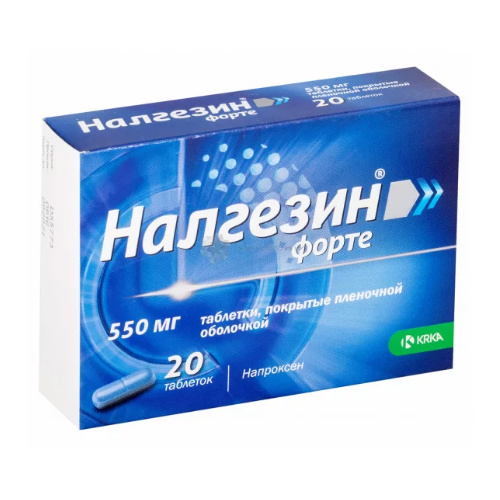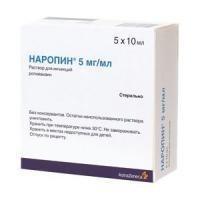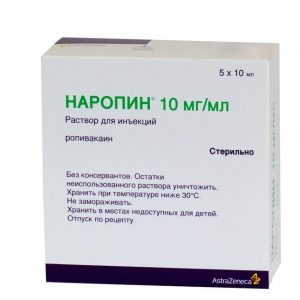Description
Pharmacological action
Pharmacological action – anti-inflammatory, antipyretic, analgesic.
Pharmacodynamics
Nalgesin forte, is a drug naproxen, has analgesic, antipyretic and anti-inflammatory effects. The mechanism of action is associated with non-selective inhibition of the activity of COX-1, COX-2.
Film-coated tablets, Nalgesin forte dissolve well, are rapidly absorbed from the gastrointestinal tract and provide a rapid onset of analgesic effect.
Pharmacokinetics
Absorption from the gastrointestinal tract is fast and complete, bioavailability is 95% (food intake practically does not affect either completeness or absorption rate). Tmax – 1-2 hours, communication with plasma proteins -> 99%, T1 / 2 – 12-15 hours. Metabolism – in the liver to dimethylnaproxen with the participation of the CYP2C9 enzyme system. Ground clearance – 0.13 ml / min / kg. It is excreted by 98% by the kidneys (of which 10% is unchanged), with bile – 0.5–2, 5%. Css is determined to receive 4-5 doses of the drug (2-3 days). With renal failure, cumulation of metabolites is possible.
Indications
Diseases of the musculoskeletal system (rheumatoid arthritis, psoriatic, juvenile chronic arthritis, ankylosing spondylitis (ankylosing spondylitis) gouty arthritis, rheumatic soft tissue damage, osteoarthritis of the peripheral joints and spine, tendinitis, radiculitis, etc. bursitis)
pain syndrome of mild or moderate severity: neuralgia, ossalgia, myalgia, lumbar ischialgia, post-traumatic pain syndrome (sprains and bruises), accompanied by inflammation eat, postoperative pain (in traumatology, orthopedics, gynecology, maxillofacial surgery), headache, migraine, algodismenorrhea, adnexitis, toothache
as part of the complex treatment of infectious and inflammatory diseases of the ear, throat, nose with severe pain (pharyngitis, tonsillitis, otitis media)
febrile syndrome in colds and infectious diseases.
Nalgesin forte is used for symptomatic therapy (to reduce pain, inflammation and lower fever) and does not affect the progression of the underlying disease.
Contraindications
Hypersensitivity to naproxen or naproxen sodium with anamnestic data on the attack of bronchial obstruction, rhinitis, urticaria after taking acetylsalicylic acid or other non-intolerant syndrome of bronchial acetylsalicylic acid polyphrenia and rhinitis coronary artery bypass grafting
erosive and ulcerative changes in the mucous membrane of the stomach or duodenum, active gastrointestinal blood echenie
inflammatory bowel disease in the acute phase (ulcerative colitis, Crohn’s disease)
cerebrovascular bleeding or other bleeding and hemostasis disorders
severe liver failure or active liver disease
severe renal failure (creatinine Cl less than 20 ml / min), incl. confirmed hyperkalemia, progressive kidney disease
inhibition of bone marrow hematopoiesis
pregnancy, breastfeeding
one tablet Nalgesin forte contains 550 mg of naproxen, so the drug is not recommended for children and adolescents under 15 years of age.
Precautions: coronary heart disease, cerebrovascular disease, congestive heart failure, dyslipidemia / hyperlipidemia, diabetes mellitus, peripheral artery disease, smoking, creatinine Cl less than 60 ml / min history of gastric ulcer, the presence of Helicobacter pylori infection, old age, prolonged use of NSAIDs, frequent alcohol consumption, severe somatic diseases, concomitant therapy with the following drugs: anticoagulants (e.g. warfarin), antiplatelet agents (e.g. acetylsalicylic acid, clopidogrel), oral glucocorticosteroids (e.g. prednisolone), SSRIs citalopram, fluoxetine, paroxetine, sertraline). To reduce the risk of developing adverse events from the gastrointestinal tract, the minimum effective dose should be used with the lowest possible rate. For children under 16 years of age, the drug is prescribed only on the recommendation of a doctor.
Use during pregnancy and lactation
Nalgesin forte is not recommended for use during pregnancy and lactation.
Special instructions
It is not recommended to exceed the doses indicated in the instructions. To reduce the risk of adverse events from the gastrointestinal tract, the minimum effective dose should be used with the minimum possible short course.
If pain and fever persist or get worse, you should consult a doctor.
Patients with bronchial asthma, with bleeding disorders, as well as patients with hypersensitivity to other analgesics, you should consult your doctor before taking Nalgesin Forte.
Caution should be given to patients with liver disease and renal failure. In patients with renal failure, creatinine clearance should be monitored. At Cl creatinine levels below 20 ml / min, naproxen is not recommended. In chronic alcoholic and other forms of cirrhosis, the concentration of unbound naproxen increases, so lower doses are recommended for such patients.
Nalgesin Forte should not be taken with other anti-inflammatory and painkillers, except for doctor’s prescriptions.
Older patients are also recommended lower doses.
Naproxen should be avoided for 48 hours prior to surgery. If it is necessary to determine 17-corticosteroids, the drug should be discontinued 48 hours before the study. Similarly, naproxen may affect the determination of 5-hydroxyindoleacetic acid in urine.
The use of naproxen, as well as other drugs that block the synthesis of GHGs, can affect fertility, therefore it is not recommended for women who want to become pregnant.
Each 550 mg nalgesin forte tablet contains approximately 50 mg sodium. When limiting salt intake, this must be taken into account.
Effect on ability to drive a car and other mechanisms: naproxen slows down the reaction rate in patients. This should be taken into account when driving a car and performing tasks requiring increased attention.
Dosage and Administration
Inside. You should strictly follow the doctor’s instructions, do not stop treatment and do not change the dosage without first consulting your doctor.
The usual daily dose used to relieve pain is 1–2 tablets. (550–1100 mg).
With very severe pain and the absence of a history of gastrointestinal diseases, it is possible to increase the daily dose to 3 tablets. (1650 mg), but not more than 2 weeks. When using the drug as an antipyretic, the initial dose is 1 tablet. (550 mg), then taken at 0, 5 tab. (275 mg) every 6–8 hours.
To prevent migraine attacks, 1 tablet is recommended. (550 mg) twice daily. However, treatment should be discontinued if the frequency, intensity and duration of migraine attacks do not decrease within 4-6 weeks. At the first signs of a migraine attack, 1.5 tablets (825 mg) should be taken, and if necessary another 0.5–1 tablets. (275-550 mg) after 30 minutes.
To relieve menstrual cramps and cramps, pain after the introduction of IUDs (intrauterine devices) and other gynecological pains (adnexitis, childbirth as an analgesic and tocolytic drug), it is recommended that the drug be administered in an initial dose of 1 table. (550 mg), then 0.5 tab. (275 mg) every 6–8 hours.
In an acute attack of gout, the initial dose is 1.5 tablets. (825 mg), then 1 tab. (550 mg) after 8 hours and then 0.5 tab. (275 mg) every 8 hours until the attack stops.
In rheumatoid diseases (rheumatoid arthritis, osteoarthritis and ankylosing spondylitis), the usual initial dose of the drug is 1-2 tablets. (550–1100 mg), twice a day, in the morning and in the evening. The initial daily dose of 1.5 (825 mg) –3 tablets. (1650 mg) is recommended for patients with severe night pain and / or severe morning stiffness, patients who are being transferred to treatment with sodium naproxen from high doses of other NSAIDs, and patients whose pain is the leading symptom. Usually the daily dose is 1 tablet. (550 mg) – 2 tablets. (1100 mg), administered in 2 divided doses.
Morning and evening doses may not be the same. With the consent of the attending physician, you can change them depending on the predominance of symptoms, i.e. night pain and / or morning stiffness.
In case it seems that the effect of the drug is very strong or weak, you should inform your doctor or pharmacist.
Side effects
Side effects are most common when using high doses of nalgesin forte.
From the digestive system: constipation, abdominal pain, dyspepsia, nausea, diarrhea, ulcerative stomatitis, erosive-ulcerative lesions and bleeding of the gastrointestinal tract, increased activity of liver enzymes, impaired liver function, jaundice, bloody vomiting, melena.
From the side of the central nervous system: hearing loss, dizziness, headache, drowsiness, depression, sleep disturbances, inability to concentrate, insomnia, malaise, myalgia and muscle weakness, slowing down the reaction rate, aseptic meningitis, cognitive dysfunction.
From the skin: itching, ecchymosis, excessive sweating, purpura, alopecia, photodermatosis.
From the sensory organs: tinnitus, impaired vision, hearing impairment.
From the CCC side: swelling, shortness of breath, palpitations, congestive heart failure, vasculitis.
From the genitourinary system: glomerulonephritis, hematuria, interstitial nephritis, nephrotic syndrome, renal failure, renal papillary necrosis, menstrual irregularities.
From the hemopoietic organs: eosinophilia, granulocytopenia, leukopenia, thrombocytopenia, aplastic anemia.
From the respiratory system: eosinophilic pneumonitis.
Allergic reactions: skin rash, urticaria, angioedema, epidermal necrosis, erythema multiforme, Stevens-Johnson syndrome.
Others: thirst, hyperthermia, hyperglycemia, hypoglycemia, increased bleeding time, hemolytic anemia.
In the event of the occurrence of such phenomena, you should stop taking the drug and, if possible, consult a doctor.
Drug Interactions
When treated with anticoagulants, it should be borne in mind that naproxen can increase bleeding time. Do not use the drug simultaneously with other NSAIDs (increased risk of side effects).
Patients concurrently receiving hydantoins, anticoagulants, or other drugs that bind to a large extent to plasma proteins should monitor signs of potentiation or an overdose of these drugs.
Nalgesin forte may reduce the antihypertensive effect of propranolol and other beta-blockers, and may also increase the risk of renal failure associated with the use of ACE inhibitors. Under the action of naproxen, the natriuretic effect of furosemide is inhibited. Inhibition of renal clearance of lithium leads to an increase in plasma lithium concentrations. Taking probenecid increases plasma naproxen levels. Cyclosporine increases the risk of kidney failure.
Naproxen slows the excretion of methotrexate, phenytoin, sulfonamides, increasing the risk of their toxic effects.
Antacids containing magnesium and aluminum reduce naproxen absorption.
If the patient has any other diseases or allergies, or when taking any other drugs, it is necessary to inform the attending physician.
Overdose
Symptoms: drowsiness, dyspeptic disorders (heartburn, nausea and vomiting, abdominal pain), weakness, tinnitus, irritability in severe cases – bloody vomiting, melena, impaired consciousness, convulsions and kidney failure.
Treatment: gastric lavage and symptomatic therapy – activated carbon, antacids, H2-receptor blockers, proton pump inhibitors. Hemodialysis is ineffective.
active substance
naproxen
Terms and conditions
prescription
lekarstvennaja form
tablets
Prescribed
As prescribed by the doctor, For the children prescribed by the doctor, Children older than 4,414 p1414 Prescribing
Adults as prescribed by a doctor, Children over 15 years old
Indications
Ushib , V vihi and rastyazheniya, from otitis, Vospalenie tendon from neurites from osteoarthritis, from bursitis , From migraine, From radiculitis, From myositis, From rheumatoid arthritis, From lumbago, From arthrosis and arthritis, From adnexitis



